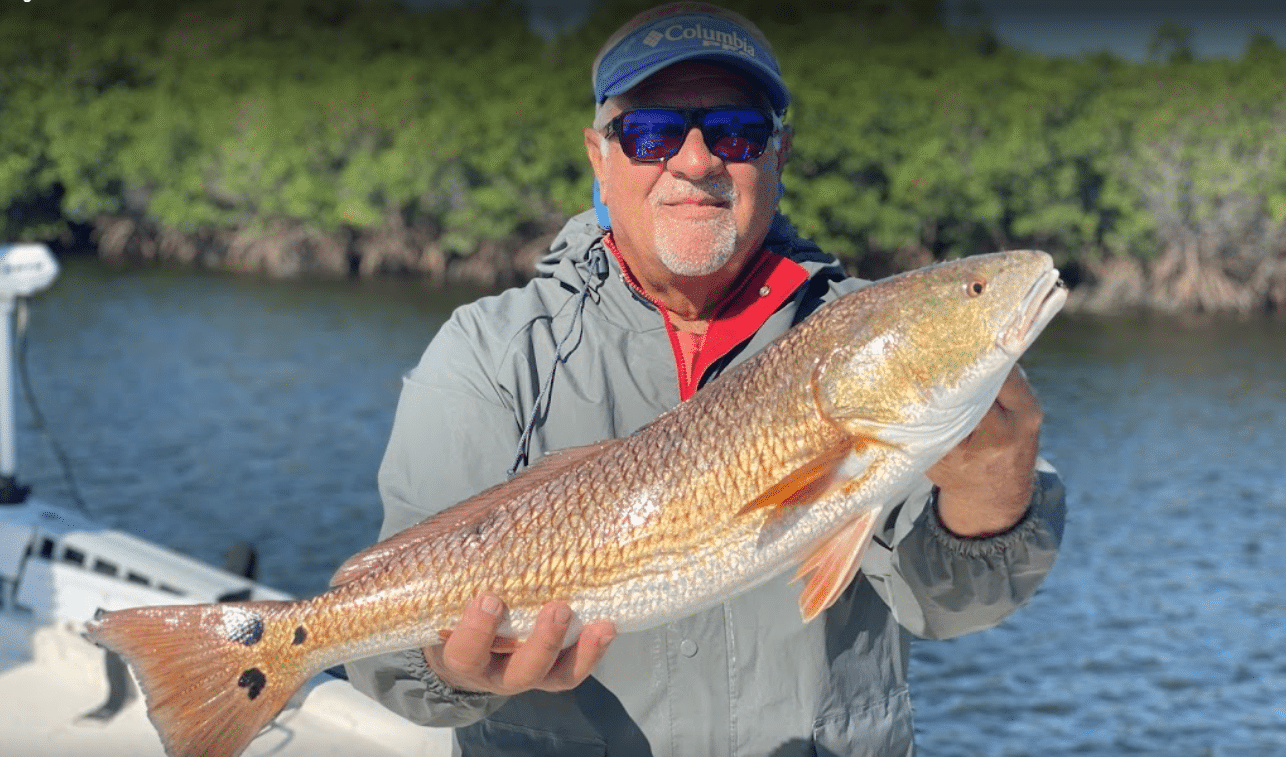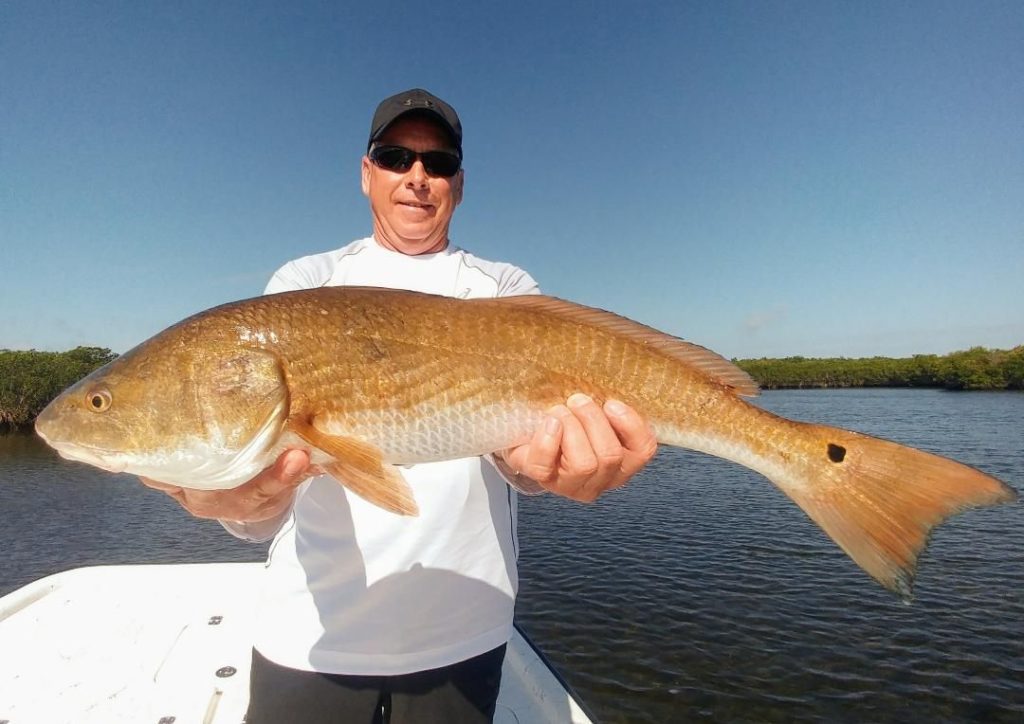
Last Updated on November 17, 2020 by Eric Bonneman
Redfish, or Red Drum, Are One Of The Most Sought After Inshore Species In Crytsal River
The Redfish (Red Drum), scientific name sciaenops ocellatus, are a favorite of Florida inshore and flats fisherman. Crystal River is a popular hot spot for this hard-fighting species. Thanks in part to a temperate year-round climate. In this, Redfish can be targeted all year. Even in the cooler months, thanks to the many spring-fed rivers that connect with the Gulf here, they can be found ready to battle.
Redfish feed on oyster bars and among grass flats most times of the year. Adult spawning redfish move out into the Gulf in the early Fall. In this, large schools can be found in the surf during the spawning months. Their primary diet consists of baitfish, crabs, and shrimp. Crystal River offers all of the primary habitats and needs that Redfish want. Making this one of the best places to target them.
5 Ways To Target Redfish In Crystal River
There are literally hundreds of techniques to target this popular species. What we will focus on are the basics that will help ensure an active fishing trip.
1. Location
Redfish can be found in some very specific locations in the Crystal River fishery. Most of the year safe bets include working oyster bars, mudflats, troughs, and pockets within the grass flats. These features can be found along the coast as well as in the backcountry.
In cooler months, you can watch the same areas, but really pay attention to the temp. If it is too cold for the shallow water areas, redfish will move out into deeper waters or back up into the rivers in search of warmer water. When the temps are like this overnight but warm up in the day, spend your time working both. Upriver in the morning and move into shallower coastal waters as the temp rises for the day.
2. Bait & Lure Choice
For bait, you have a choice between live, frozen, and cut. All three can include whitebait, shrimp, finger mullet, and small crabs. The differential will be, again, water temp. In the warmer months, an active live bait works fine. In cooler months, cut baits and frozen baits will work best – as the fish get more lethargic and are looking for easy food.
Lure choices are pretty broad but keep the same concepts. Fast in the warm weather, slow in the cool weather. Fast action twitch baits, topwater lures, and soft baits (shrimp or paddle tail) will all work great in warm water. In cooler months, bucktails, sliders, and soft plastics should be a priority. But keep the others handy in case the temps rise during the day.
3. Work The Tide
As with all coastal fish, activity spikes with a moving tide. On an incoming tide, the best bets are to hit the locations redfish cannot feed on during the low tides. These can include the backside of mudflats, grass flats, and especially oyster bars.
During a stagnant high tide, you will find a lot of success on the edges of structures, along drop-offs, and over grassy areas.
On an outgoing tide, fish the bottlenecks where the waters are flooding out. This can be the one tide swing where you’re window to target these fast-moving fish gets pretty small. On an outgoing, they tend to flood out in a mad rush.
With a stagnant low tide, you will need to find deep pockets with direct access to deeper waters. In Crystal River, going up coastal rivers is also a great choice.
4. Bait & Lure Presentation
Redfish can be pretty frenzied eaters when in the mood (most of the time). In warm weather, fishing the proper structure and tide will allow nearly any redfish bait to work, in nearly any fashion. This includes both slow and fast actions. In cooler months/days, stick with slow action.
Topwater lures work great during the spring and summer (even into early fall), as Redfish are actively eating schools of baitfish in the area – this mimics that. The same can be said with twitch baits and even fast-moving paddle tails.
However, at their core, this species is a bottom feeder.
So, when it comes to fishing the bottom, this is where you want to move slowly with soft plastics. Some great tips are to bump the soft plastic across the bottom with a slow retrieve. Or, you can pop the bait way up off the bottom quickly and then let it naturally float back down.
Fly fishermen will want to use all of the same techniques. Fly fishing for redfish is one of the most popular methods along Florida’s coast. Stick with both baitfish and crustacean fly patterns and adjust your strip/fly in accordance with current water temps.
5. Watch For Tailers (Sight Fishing)
This is the best part for those that love the hunt. Since reds are bottom feeders, along the shallow flats, you can see them bottom feeding with their tail straight up out of the water. When cruising shallow waters they form what is called a “push”. This is a wake of water that is sliding right over the top of their heads. This is what makes them one of the most popular sight fishing species as well.
Really studying the surface of the water, being quiet, and gently moving the boat along can lead to a multitude of sight fishing opportunities. You’ll want to lead the tailing fish just enough not to spook it, and then work the lure back to meet within the strike zone of that feeding red.


I had a half a dozen bull reds tailing within 10 foot of my boat without even flinching a bit. I threw chunk mullet down and jigs without even a bite, but I did not have Shrimp and that was probably the thing I needed. Yankeetown, Fl.
If you give it a try let us know how it goes!